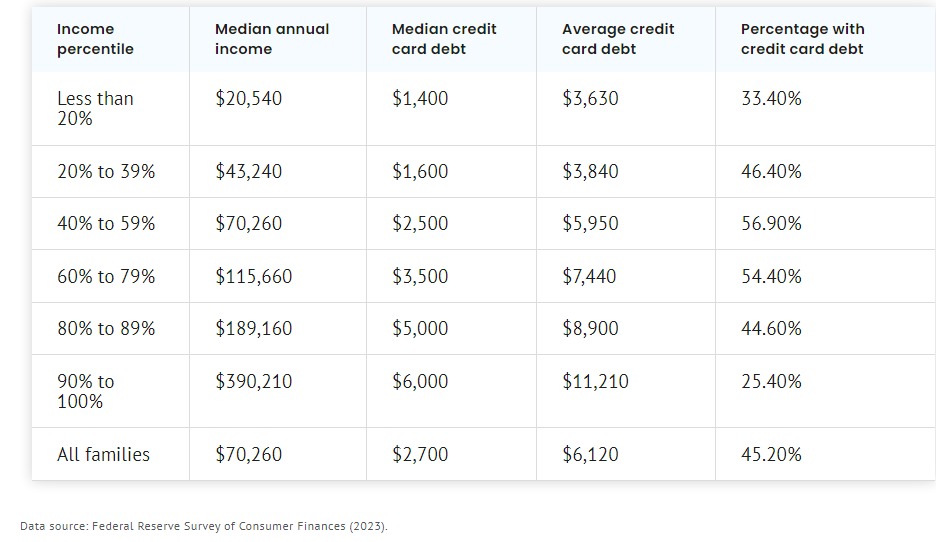It’s baffling how Americans can endure carrying credit card debt at unbelievably high interest rates (21.67% – 24.72%) knowing they will have to pay that balance as it exponentially grows, the longer they ignore it. Yet, if they had invested that money into their future, they may have received a similar gain or return on that investment this year.
Why are people fine using intangible digital wallets and contactless payments securing a comfortable and emotionally rewarding present but so afraid of securing a comfortable and emotionally rewarding future?
The present is tangible.
Those in the 90% – 100% income percentile is most baffling.

Saving money does require strategy but saving money in a bank is tangible.
It is very accessible.
You can transfer it.
Go to an ATM to get it at any time.
It doesn’t lose value ever.
It is insured up to $250,000.
It does gain value, but at an exceedingly slow rate of return.
Investing money is different. There is an elusiveness and uncertainty to it. It requires a level of confidence and endurance because you know failure and loss are inevitable. For some, the imminent risk of failure and the unknown is too great to even try and for others, they become so short-sighted they have to take action when a loss prevails. When really the only way to gain the confidence and endurance as an investor is to start and continue to do it for years, not months, not days, not until a crash but year after year after year.
My husband and I didn’t start tracking our assets/investments, debt and net worth until March 2012. When we recalculated in June 2012, we had lost almost $20,000. The loss we told ourselves was only if we sold everything at that point in time. So, we didn’t and kept tracking.
We built a separate “growth” calculation to track the change in our net worth (without house equity) each time we updated our tracking several times a year. In the last 12 years, we lost thousands of dollars 14 times during those years. But we also gained 49 times during those same years. If we only focused on the losses, we would’ve quit and sold out long ago.
For investing, you have to focus on the long-term strategic. You can’t approach it the same way as tracking your income and expenses month-over-month which is short-term tactical. By tracking your net worth and growth year after year, it has an impact to your financial future than you can’t comprehend in the present.
You can control your tracking, but you can’t control what the market does. It gives you something tangible to handle the ride of volatility, tracking the losses that intermingle with the gains. Just like a roller coaster ride, the vertical drops become less shocking and survivable while the climbs become motivating and actionable to make you continue to do it all over again. It gives you momentum to contribute more and why people max out their contributions to their 401(k) or IRA.
How do you make investing more tangible?
- Track your assets/investments, liabilities/debt and net worth. Recalculate at least quarterly.
2. Track the change in your net worth each time you calculate it. You can even graph it like we do and call it “Growth.”
The times of loss make you cautious. You reassess how much debt you have. It makes you focus on controlling and reducing that. The times of gain give you momentum to keep going just like we recalculated for 3 straight months that first year of tracking.
| Date | Net Worth | Change | |
| Mar-12 | $136,421 | ||
| Jun-12 | $119,057 | ($17,363) | 1 |
| Oct-12 | $170,069 | $51,012 | 1 |
| Nov-12 | $201,421 | $31,352 | 2 |
| Dec-12 | $227,932 | $26,511 | 3 |
3. Track your milestones.
The dates your total net worth hits $250,000, $500,000, $750,000, $1,000,000 adjusting the scale as you build.
The day you pay off your credit card debt, cars, house.
The day you buy a new asset/liability.
4. Track assets by year.
I’m setting up this calculation since we have the data to see year-over-year change in balance by asset. The same could be done for liabilities.
5. Know your rates of return.
Most brokerage accounts where your 401(k), IRA assets are held will now have some option to view your rates of return for current year, 1-year, 5-or-10-year or lifetime of the asset.
My IRA at Schwab that I opened for my last 401(k) rollover and have only tracked it since.

Your account gained $113,195.95 from Nov 2, 2023 to Nov 1, 2024, excluding net contributions.
Compounding Interest – He (or She) who understands it, earns it; he (or she) who doesn’t, pays it. – Einstein
It is easier to visualize saving for a new car or house. Saving for your freedom or retirement chapter of life is much more difficult because there is no tangible object to set your sights on. You have to create it.
Focus your attention on building your cache instead of what your cash can buy for you. It won’t be as instantly gratifying but it will be far more valuable.
Average American Credit Card Debt in 2024 | The Motley Fool
Why Are We So Impatient? A Look into Money and Delayed Gratification | St. Louis Fed
Featured Image: Face Rock State Scenic Viewpoint – Coos Bay, Bandon, Oregon – Photographer Cary Wauters
“The cave you fear to enter holds the treasure you seek.” – Joseph Campbell

